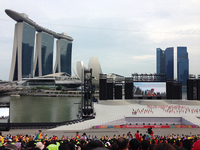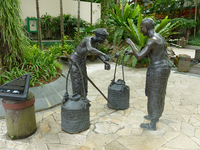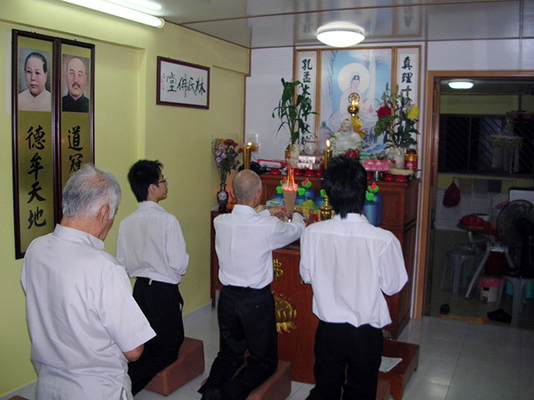Read more about Singapore Sociology

After Globalization
by Daniel P.S. Goh

After Meritocracy
by Youyenn Teo

After Multiracialism
by Noorman Abdullah

After Lee Kuan Yew
by Vineeta Sinha
February 17, 2017
In many ways, to be a Singaporean entails a constant negotiation with a state-imposed system of social classification, in both public and private life. Of course, all modern nation-states engage in defining, circumscribing, and hence governing the different social and cultural groupings they encompass; these are after all the essential tools of governance and modern nation-building. Being a Singaporean involves constant engagement with the state’s inscription of three key identity markers. Race, language and religion are essential narrative themes in the nation’s founding myth as well as important governance tools through which the state seeks to exercise social and political control.
When every school student recites daily Singapore’s “Pledge” to be one united nation, “regardless of language, race, and religion”; when each citizen must declare their “race” on their national identity card; when the Presidential Council for Minority Rights and the Maintenance of Religious Harmony Act (1991) are key to Singaporean multiculturalism; when some Christians have been convicted for sedition for over-zealous proselytism, while some “self-radicalized” Muslims have been detained under the Internal Security Act for their alleged terrorist plots; it is easy to see that in Singapore, issues of race, language and religion are deeply intertwined and politically charged.
For the Singaporean government, secularism is considered essential for the peaceful coexistence of the country’s diverse religious and ethnic groups. Any sociological research on issues related to ethnicity and religion must grapple with the fact that Singapore is a multi-religious society with an officially secular state. Singapore’s religious plurality is largely the consequence of contingent, historical factors, including its former status as an important trading colony that attracted diverse communities from the Asian region and beyond. The promotion of secularism, however, stems from the state’s conscious ideological work since the nation’s founding – a persistent effort, inextricably bound up with the circumstances under which Singapore separated from the Federation of Malaysia in 1965, and with efforts by its political leaders and citizens to carve out a national identity that stands in contrast to the strong Islamic cultures of neighboring Malaysia and Indonesia.
For an avowedly secular state, it is striking that Singapore has a Minister-in-charge of Muslim Affairs. On the Eid al-Adha (the Feast of Sacrifice) in 2016, the minister warned Singaporeans to reject ideas that might undermine integration, and reminded them that the religious occasion was “also a good time to reflect on religious and racial integration in Singapore.” In the country’s public political discourse, Islam is often portrayed as the Other – both in relation to Singapore’s self-perception as a secular nation-state, and as a potential threat to social harmony linked to a perceived global spread of “extremist” ideologies.
In a context where a strong state actively slots peoples into neat categories, where “races” are defined through cultural difference such as language and religion, sociological research touching on ethnicity and religion tends to adopt two different approaches. One approach, in the more positivist sociological tradition, treats “race” and “religion” as independent variables. A second approach critically examines how power shapes boundary-making, exploring how the boundaries of both ethnicity and religion may shift and blur on the ground, producing ambiguous, mixed, or multiple identities that defy neat classification. Thus, research on religious pluralism in Singapore finds that many participants in popular Hinduism and Daoism (from “Indian” and “Chinese” communities, respectively) worship deities such as Muneeswaran, Tua Pek Kong, Tai Seng, Lord Krishna, and Hanuman, hailing from two religious traditions. Some of these deities are even housed in the same temple grounds.
Critical studies of secularism suggest that secularism may help legitimate Singapore’s multiracialism in pursuit of social harmony, but they also emphasize secularism’s role in efforts to instill “objective” and “rational” deliberations in the political and policymaking process. Singaporean-style secularism is not the anti-theistic, militant version that can be found in some Communist countries; rather, Singaporean secularism recognizes the importance of religion in people’s lives, and, in principle, accords equal treatment to all religions. Quite apart from the constitutional guarantee of freedom of religion, the state encourages various religious groups to contribute to societal needs, especially in the provision of social welfare services and in promoting moral and cultural values.
Singaporean secularism involves two essential aspects. On the one hand, the state insists on keeping religion out of politics, most notably by prohibiting religious organizations from mobilizing their members for political activism. On the other hand, the state aims to control and manage religious communities by installing government representatives as “advisors” to religious organizations such as the Singapore Islamic Council (MUIS), temples, mosques, or faith-based voluntary welfare groups. These “advisors” act as checks on the ground, shaping religious discourses so that they converge with the state’s agenda.
Like many modern states, Singapore legally certifies places of worship for various religious groups, deploying a functional conception of territoriality underpinned by the ideology of development and modernization. As a city-state facing land scarcity, the authorities embrace a highly utilitarian and interventionist urban planning approach. When the Singapore Land Authority acquires land previously occupied by a religious organization, religious groups have been forced to move, shut down, or even combine congregations. For example, Chinese temples previously located at different sites have been brought together to form “combined temples,” with different altars from the formerly separate temples now housed in a single building. Recently, the government has proposed constructing multi-story buildings where various religious groups would rent spaces for their activities.
Many researchers on religion in Singapore have examined state strategies for managing and regulating religion, but there has been less research on how some religious groups find innovative ways to circumvent secularist policies. For example, Terence Chong, Daniel Goh and Mathew Mathews have investigated how some evangelical Christians seek to subtly shape policymaking and political discourse by co-opting political leaders, and expressing support for the government’s conservative policies on matters relating to sexuality and the family. Studies of popular Hinduism, including Vineeta Sinha’s work on Muneeswaran worship, describe ritual activities conducted in forested areas, out of the authorities’ sight. My own research examines how the Yiguan Dao, a transnational “salvation religion” of Chinese origin, has converted public housing apartments (officially “secular” sites) into temples. Similarly, Christians have organized “cell group” meetings in their homes, while Chinese spirit mediums and Daoist priests have established “house temples.”
These cases suggest a possible limit to Singapore’s state management of religion, resulting from the secularist distinction between “private” and “public” religious domains – a distinction which may create both a limitation on the state’s ability to completely control religion, and the space for certain religious groups to operate outside the official purview of the state.
Francis Khek Gee Lim, Nanyang Technological University, Singapore <fkglim@ntu.edu.sg>
This issue is not available yet in this language.
Request to be notified when the issue is available in your language.
If you prefer, you can access previous issues available in your language:

















